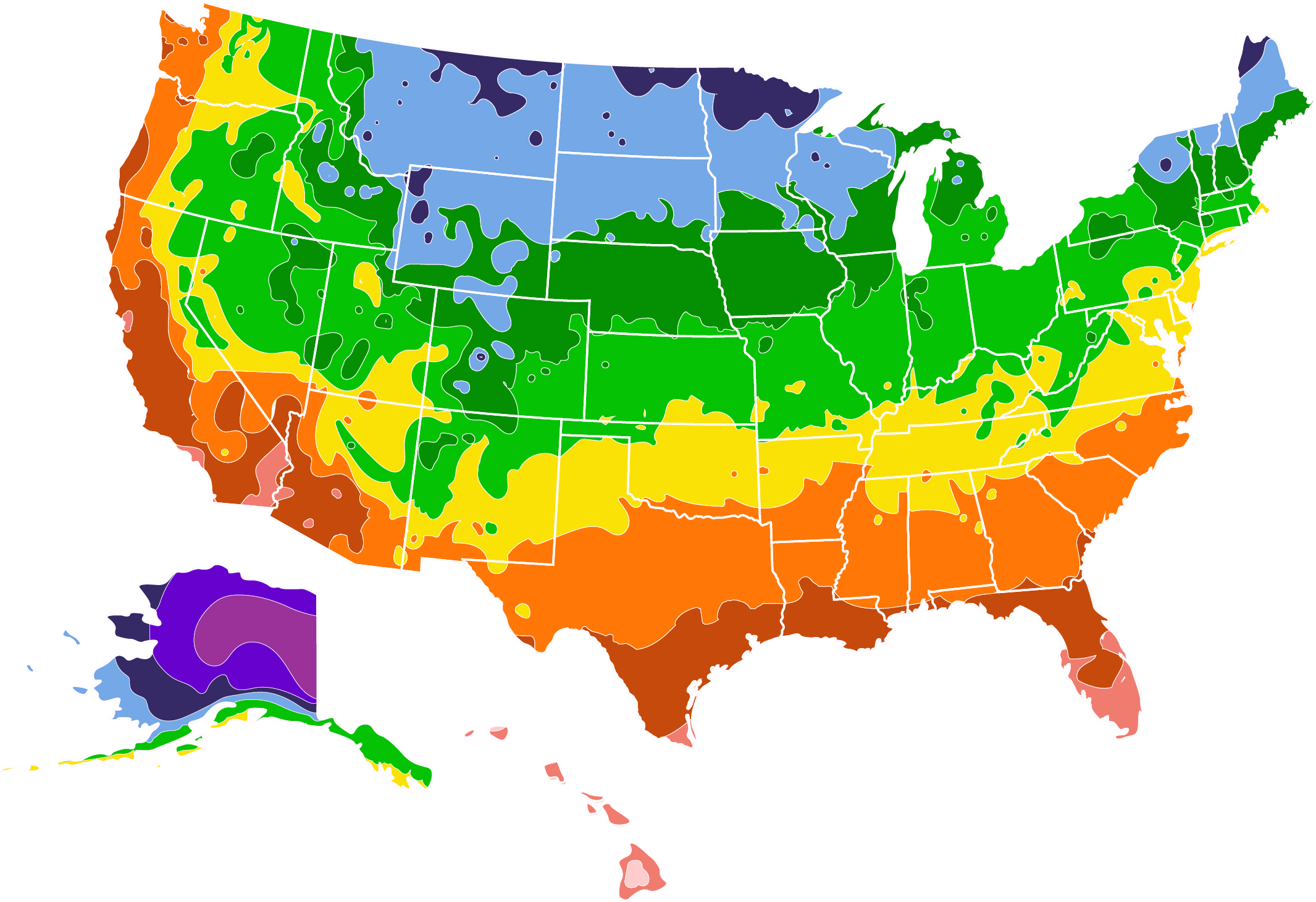- Home >
- Ornamental Plants >
- Bachelor Buttons
Bachelor Buttons for Sale - Buying & Growing Guide
Plant Care
Sunlight
As long as this plant receives about six hours of sunlight or more, it will be easy to maintain.
Watering
Supply water weekly, but try not to get the leaves excessively wet.
Fertilizing
Use a balanced fertilizer once per month or less.
Bachelor’s button (Latin name: Centaurea cyanus, Family: Asteraceae) is an annual flowering plant native to Europe. The flowers of C. cyanus look like blue miniature carnations with grey-green stems, but they are much easier to grow. The species is also referred to as cornflower, as it is often found growing as a weed in fields of corn and grain. Once established, the plant is exceptionally drought-resistant and will self-seed. Here are some other notable facts about bachelor’s buttons:
- Allow the blooms to reseed to enjoy them year after year.
- This easy-to-grow plant is recommended for children and beginners.
- The foliage is deer-resistant.
Planting and Care
Planting instructions
Bachelor’s button can be sowed directly in the ground, as the young seedlings do not take well to transplanting. Bachelor’s button plants are cold-hardy and are best sown in early spring. You may grow Bachelor’s buttons alongside sturdy perennials, as they will act as natural support systems. Sow seeds directly into your garden by covering them with about one half inch of soil. Keep moist until germination begins, which should occur within seven to 10 days if soil temperatures are above 60 degrees Fahrenheit (ideally, the soil temperature will be between 70 to 80 degrees). It takes about three months or more for this plant to grow from seed to flower.
Watering and nutrients
Once the plants are in the ground, make sure they receive at least one inch of water per week. Be sure to plant in well-drained soil to prevent any fungal infections. This is especially important during hotter months (like July and August), as heat and excess moisture are ideal conditions for mold and mildew. Avoiding overhead watering and generally keeping the leaves dry is an effective way to prevent fungal infections. Watering in the morning is also a wise tactic, as the sunlight throughout the day will dry any water that lands on the leaves and reduce the odds of infection.
If you have poor soil, fertilize your bachelor’s buttons once a month during the growing season with a general purpose fertilizer or a light layer of compost.
Pollination
Cornflowers attract a variety of pollinators, but bees are the most common visitors. When the fertile center of the flower is brushed by a bee, it releases pollen that can fertilize another plant. If you want your cornflower plants to produce more flowers, try the pinching technique: when the plant reaches six to eight inches in height, pinch back the plant at its topmost node (where the leaf stem meets the main plant stem), removing the excess. This will cause the plant to develop side branches, creating more potential area for flower production and attracting a higher number of pollinators.
Pests and diseases
Common cornflower pests include aphids, cutworms, and leafhoppers. You can take preventative measures, such as attracting other beneficial insects like lady beetles or hand-removing the leaves that eggs are laid on. Disease may come in the forms of mildew, rust, and aster yellows. You can prevent most of these issues by ensuring your plants have well-drained soil. Avoid overwatering your bachelor’s buttons, as excess moisture can lead to fungal infections. If the plants become crowded, cut them back to increase airflow.
Soil
Cornflowers need well-draining soil and can grow in poor quality soil lacking in nutrients, but grow best in soil that is high in organic matter. Before planting, work compost into clay or sandy soil to help create a balanced environment that will be both well-draining but also have some capacity to retain moisture.
Though cornflowers are drought-tolerant, they prefer moist soil, and the addition of organic matter into the soil will help to achieve this without making it boggy. A moist soil will help to contribute to a more prolific bloom and a longer flowering period. Cornflowers are not bothered between alkaline, neutral, or acidic soils and will grow well in either.
Light
Cornflowers need full sun and will not tolerate full shade just like other wildflowers like foxgloves, hydrangeas. Plant cornflowers ideally in south-facing aspects where they can benefit from sunlight all day. You should aim to ensure they receive 6 to 8 hours of light each day, though if they are planted in partial shade, position them so that they have full sun in the morning and are shaded in the middle of the afternoon. This will give the plant some relief from the heat at the hottest point of the day, though they usually tolerate heat well in all but the most extreme circumstances. Too much shade will cause the plants to flop over, so watch out for this sign that your cornflowers need more sun.
Temperature
Cornflowers are very hardy plants and are suitable for planting in USDA growing zones 2 through 11. The plant is not frost tender and performs as a reliable annual. It is tolerant of both cold and hot temperatures, making it a great plant to grow in a wide variety of climates. There are some varieties of cornflower which grow as perennials, though these are not the common cornflower.
Pruning
If you’re a lazy gardener, you can leave your cornflowers to their own devices, and they will do just fine without pruning. However, if you like to get involved with your plants, then there are pruning methods you can use to get the best out of your plants.
To encourage a bushier growth, you should pinch back cornflower stems late in winter or early spring. This will result in a more dense looking plant, and it will also help to promote stronger flowering. To pinch back your cornflowers, sift through them using scissors or your fingertips, removing the top part of the stem and the top set of leaves. Make the cut at the point where the next set of leaves are joined to the stem.
Deadheading is also a pruning method you can implement with your cornflowers. Rather than just removing the spent flower itself, remove the stem. The flower is attached to back to the next set of leaves. Deadhead your cornflowers throughout the blooming period whenever you spot a spent flower; this will lead to more blooms and an extended flowering period.
Deadheading will also prevent the plants from self-seeding, so if you did want to encourage this, you would need to leave a few spent flowers untouched. The seeds that develop from these flowers also make an important source of food for wild birds.
Propagation
Cornflowers grow best from seed. You can sow them outside directly into the ground soil, or sow them indoors for transplanting outdoors later on. Cornflower seeds can be sown outside anytime during spring and summer, so long as the final frost has passed. Seeds sown between March and May will produce flowers in August and September, while those sown in August and September will flower early in the season the following year.
In mild climates, you can sow cornflower seeds outdoors during winter. To sow the seeds, spread them thinly on moist soil and cover them with a thin layer of soil. The soil should be kept moist for the seeds to germinate. Once seedlings have appeared and reached a size that is big enough to handle without causing damage, you can thin out the seedlings so that there is a gap of between 5 and 10 inches separating each plant. This will ensure there is enough space for the cornflowers to grow.
Remove any weeds that appear amongst the cornflowers as these will inhibit your plant’s growth. Growing cornflowers from seed are very easy, with success rates high. They grow quickly and should reach their full size in just 3 or 4 months. Cornflowers are also prolific reseeders, and you may find that you have more of these plants growing in your garden each year without having planted any seeds yourself.
If you wish to prevent the plant from self-seeding, then you simply need to deadhead the spent flowers, as this will ensure they don’t have the opportunity to turn to seed. If you’d like to encourage self-seeding, then leave spent flowers to develop into seed, which will disperse themselves in the wind, via birds, or as they drop to the ground.
Flowers
Cornflowers produce pretty flowers in deep blue, blooming for several months from early spring to mid-summer. The flowering period can be extended to late summer if the flowers are deadheaded. Cultivars of the plant can produce flowers in shades of lavender, pink, and white, and they make excellent cut flowers. They are also commonly used for making dried flower displays. The flowers are particularly attractive to birds and butterflies.
Bachelor’s Buttons Plant Varieties
Centaurea cyanus ‘Black Magic’
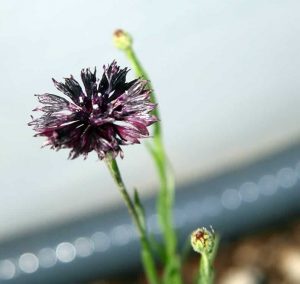
This cornflower features striking flowers in an unusual deep purple-maroon color. They look especially stunning in cut flower bouquets. Growing to heights of between 2 and 3 feet, this dramatic wildflower makes a statement in any garden. The flowers are also edible and can be used for decoration in salads or desserts.
Centaurea montana ‘Gold Bullion’
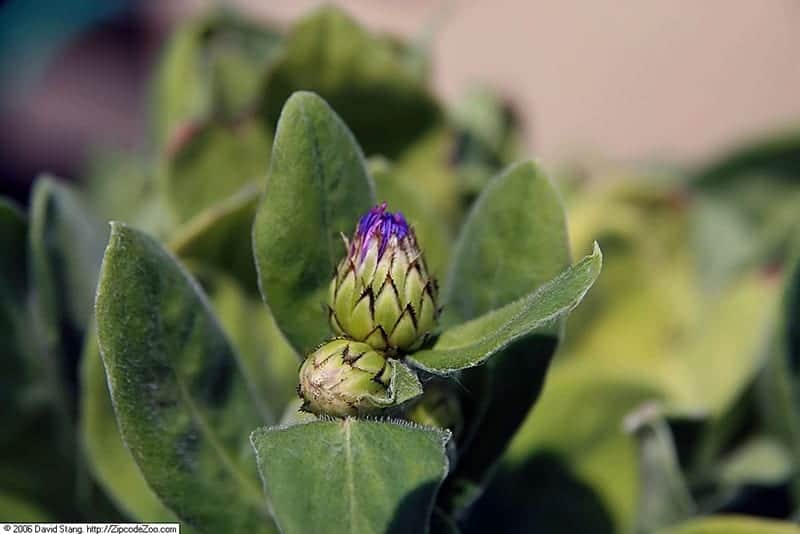
This is a cultivar of the perennial mountain cornflower, which has stunning unusual colored flowers and foliage. The leaves of the plant are a golden yellow, while the flowers are a contrasting pale purple with dark red centers. It grows between 1 and 2 feet in height.
Centaurea montana – Mountain Blue
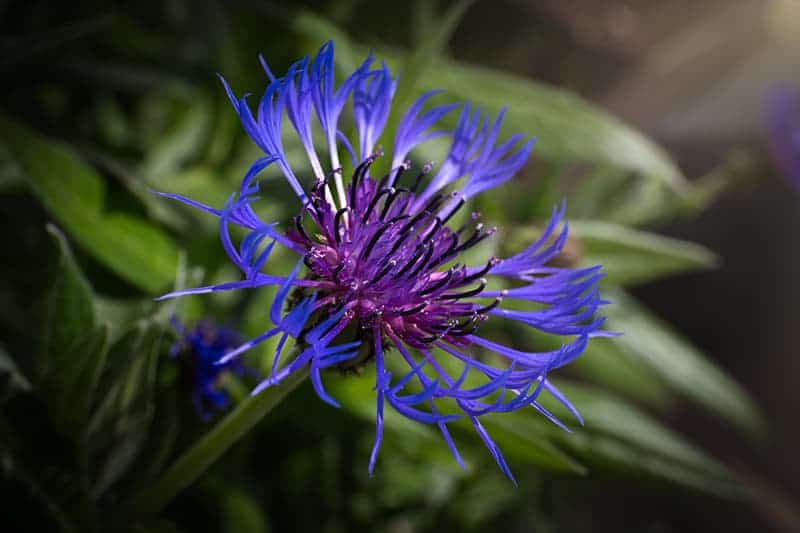
This is the perennial cornflower, which grows to 2 feet in height with a similar spread. It has a shorter blooming period than the annual cornflower, typically flowering in early spring until early summer. Its flowers are purple-blue, though other cultivars exist with a range of flower colors. It is hardy from USDA growing zones 3 through 8.
Centaurea montana ‘Black Sprite’
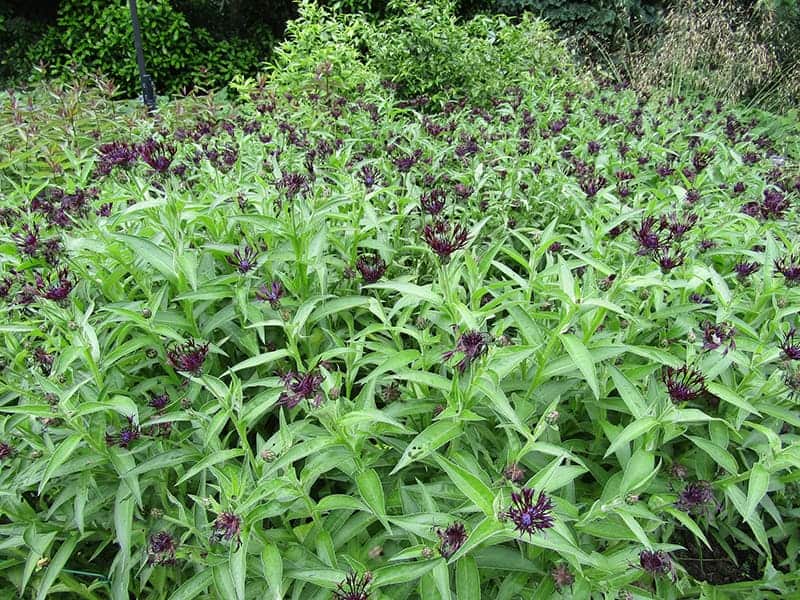
Another perennial cornflower, this variety features unusual flowers in dark purple and black. The blooms are star-shaped, growing atop of stems that reach up to 35 inches in height.
Centaurea montana ‘Amethyst Dream’
This dramatic perennial cornflower has deep purple flowers that bloom in the middle of summer. It grows to around 20 inches tall.
Centaurea cyanus ‘Dwarf Blue Midget’
This dwarf version of cornflower grows to between 6 and 12 inches tall, making it ideal for growing in containers or flowerbeds. It features blue flowers that bloom from June to September.
Centaurea cyanus ‘Florence Mix’
This is another dwarf version of cornflower, reaching a maximum height of 12 inches. It blooms from June to August in a variety of colors, including pink, white, and blue.
Centaurea cyanus ‘Blue Boy’
This compact variety also tops out at 12 inches tall. It features double flowers that resemble thistles in intense shades of blue. It blooms in August and September and is especially attractive to bees and butterflies (Gardeners World).
FAQs
Do bachelor’s buttons come back every year?
Are cornflowers edible?
Bachelor’s buttons are edible and have a sweet and spicy taste with a hint of clove. The flower buds contain a variety of vitamins and are a perfect addition to salads. You can also use the dried flowers as an addition to your favorite tea blend. The blue petals (or whole flowers) can be used to dress up a fancy drink or to garnish a special meal. The blooms can also be used as a natural blue food dye.
Can I save bachelor’s button seeds?
Yes! To collect the seeds from a flower, wait until it begins to wilt. Then, remove the flower from the stalk. Break up the flower until the seeds emerge from inside. The oval-shaped seeds will appear to have tiny hairs sprouting from them. Set the seeds out to dry for a day or two. Once dry, save them in a container of your choice. Bachelor’s button seeds can be replanted a few weeks before the last frost date in spring. In warmer climates, the seeds can also be planted in the fall and the plants will appear in the spring.
Should I deadhead my bachelor’s buttons?
Deadheading is the process of removing dying flowers to encourage new blooms to form. Bachelor’s buttons do not require deadheading, but you may wish to perform the practice for a few reasons. More flower growth will create more beauty in your garden, as well as attracting pollinators in higher numbers. This is a useful practice if you are growing the plants for seed as well — a greater number of flowers will lead to higher quantities of seed. Deciding not to deadhead also leaves this plant's seeds available to the bird species that eat them.












